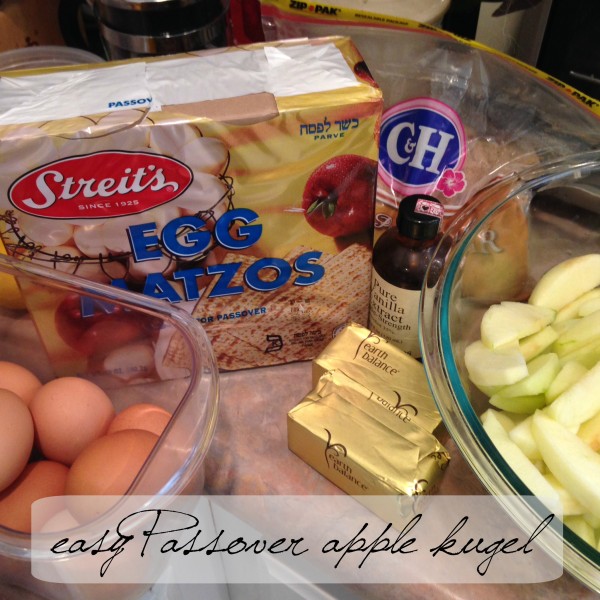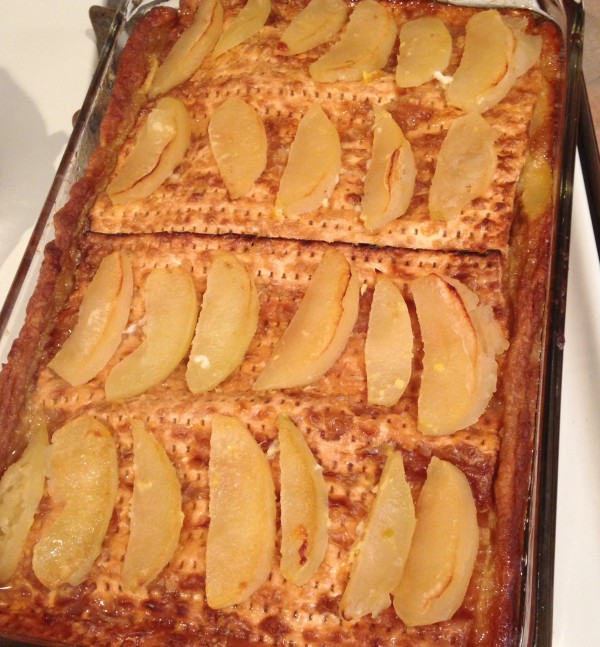encore: Passover apple kugel
If you’ve been invited to a Passover seder and aren’t sure what to bring, this recipe is very easy and has always been a hit. Yes, it’s a side dish, but don’t be surprised to find people going back and nibbling on it for dessert.
Happy Pesach to those who celebrate! Here’s an easy side dish for Passover that I make every year for our family Seder. It’s rich and rather sweet, so some serve as a dessert, but it does make a nice side for a savory dish like a brisket.
This Passover kugel recipe is almost impossible to mess up. 🙂 Because we usually have a large crowd to feed, these quantities serve 10-12. You can easily halve recipe and use a smaller baking dish.
- 4 apples, peeled and sliced thin (I like to use Granny Smiths)
- 6-8 Matzohs
- 8 eggs
- 1-1/2 cups sugar (either brown or white; I used brown this time)
- 1-2 tsp lemon zest
- 2 tsp vanilla
- 2 sticks butter or margarine at room temperature to soften (if anyone at the meal keeps Kosher and if meat will be served, you need to find a margarine that has NO dairy and is labeled “Parve”. I used this Vegan spread from Earth Balance.)
- optional: raisins, dark or golden (I forgot to buy this time)
Preheat oven to 450F and use the margarine wrappers to grease a 13 x 9″ baking dish.
In a large bowl, beat the eggs, then add the sugar, lemon zest (and some juice if you like), vanilla and the sticks of margarine cut into chunks. Mix well. The margarine will still be chunky; that’s OK. If you have raisins, add those to the liquid as well.
Rinse each of the matzohs in running water for a few seconds to soften. I recommend doing this one at a time as you use them; that way they remain intact. Layer 2 matzohs in the bottom of the baking dish, then layer 1/3 of the sliced apples and top with 1/3 of the liquid mixture. Repeat this sequence two times. You can sprinkle some more raisins on top if you like.
Bake uncovered for 15 minutes at 450F. Lower heat to 350F, cover and bake another 40 minutes. Can be served warm or at room temperature.
If you’re handy in the kitchen, you can also do something pretty with that top layer. I’m not. 😉 Here’s how mine looks coming out of the oven.
In past years I’ve also added cinnamon, reduced the amount of sugar, and tried different types of apples. Play around with the ingredients to suit your taste.
Do you have a favorite Passover dish?

Stay in touch
Sign up to be notified of new posts and updates from une femme d’un certain âge.




I am not Jewish, but may try this anyway. Pesach Sameach to you!
I make my “famous” Charoset with dates, which I cook first. The recipe such as it is, is kind of haphazard, but is essentially 1 chopped apple: 6 oz. chopped nuts: 1 8 oz box of dried dates (I usually make this times 4). Put all the dates in a large deep pan, and almost cover with water, bring to a slow boil, stirring all the while (there is sugar in the dates, so they will scorch easily). When the reach the consistency of a thin paste, remove from the heat and allow to cool while you chop the apples and the nuts. Fold it altogether, and refrigerate until its time for dinner.
Our “family” is actually two families not actually related to each other, who have been having holiday meals together for almost 40 years…plus a few extras). There will be 16 this year, and my daughter will be hosting for the first time. I make enough of this stuff to have a heaping bowl on the table, and everyone is able to take some home. I know this will be a little different for you this year; I hope you have a good holiday.
Famous (in my family) for my brisket. This year I’m making a side dish with layers of matzo, spinach, artichokes and feta cheese) – not really traditional because of the dairy but we have a few vegetarians in the family. Your apple kugel looks great.
Stuffed Eggplant, Matzo Brie Kugel (my recipe mash up), and homemade, not from a jar, beet borscht.
Chag Sameach !
My mother’s charoses, although in the Midwest, at least, one can’t get the right apples (a combination of Jonathans and Macintoshes) in spring any more—growers came to find it too expensive to keep apples in storage, I’ve heard—so I buy one or two varieties of the most flavorful red apples available, plus Granny Smiths for tartness. Peel, core, and chop them moderately finely; chop walnuts and pecans a little more finely; mix with ground cinnamon and Manischewitz kosher l’Pesach blackberry wine, until it tastes right. Gut yontov to all!
Happy Passover! I am usually asked to make the “famous” Scacchi (an Italian layered vegetable/matzo dish). Layers of sauteed mushrooms, onions, spinach and artichokes between layers of soaked matzo, covered with an egg mixture and baked. Homemade fresh strawberry pie in a hazelnut crust is another favorite “famous” dish.
How much I love that you are a kindred sister. Not only am I a total Francophile but I’m also in the process of preparing for our Seder too. I love your travel fashion hints for une femme d’un âge certain!
Please light a candle for Mme Mireille Knoll. I think she was the same age as a casually chic Parisienne friend, of Italian-Jewish origin who had to wear the yellow star in Paris and whose family actually found refuge in Fascist Italy. She was also very involved in her neighbourhood and welcoming to people of all origins, as my friend is.
this looks wonderful, Susan!
-Patti
http://notdeadyetstyle.com
Chachouka!!!
I must confess that most of the Pessachs I’ve taken part in haven’t been very strictly kosher. (Note, I’m not Jewish, but have many friends and chosen family who are, here in Montréal, in France and Italy and even in Argentina). No, of course there was no pork or shellfish, but even the Ashkenazi friends admitted the Sephardic legumes and rice. By the way, those have now become licit for many Ashkenazi people, and of course for many the vey nutritious “pseudograin” Quinoa- hey, as in pseu – is permitted, so taboulehs galore.
Thanks for sharing your tasty-looking recipe. I recently bought the Nordstrom Halogen lace-up flats and am wearing them to our Seder. The food will be traditional, but that will spice things up for me!
A favorite has always been my borscht mold. I know; gelatin salads have (blessedly) fallen out of favor, but this is one recipe I keep and make for the family Seder. It’s made with lemon gelatin, borscht, beet horseradish, then gefilte fish added to the partially set gelatin. I make this in a ring mold, then slice it into individual servings, and everyone gets a piece of the gefilte fish along with the borscht salad. Oddly, this combination works, and has converted both borscht and gefilte fish haters with this refreshing side dish.
Late to the party, but I’m going to make this for our Seder in 2017.
Happy Passover! Thank you for the recipe!!!!!!!
Chag Sameach and you’re welcome!